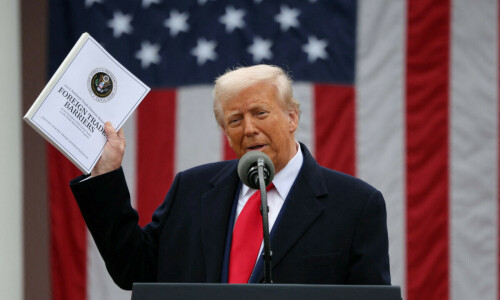ISLAMABAD: The federal government collected revenue of more than Rs1 trillion from the oil and gas sector in 2016-17.
The oil and gas sector is the single largest revenue contributor to the national kitty. The collection from the sector was Rs912 billion in the preceding fiscal year. The annual increase in total revenue collection was 11 per cent, which is almost identical to the rise in the collection from the oil and gas sector.
Three major factors are reported to have made a healthy contribution to the national exchequer: highest sales tax rates, increase in consumption and higher international oil prices.
The figure does not include provincial tax collections through oil and gas and taxes arising out of the value addition to oil products, such as power generation that is almost 70pc dependant on furnace oil, liquefied natural gas and natural gas.
FBR collected more than Rs650bn from oil and gas companies in indirect taxes, up 12pc from a year ago
The Ministry of Finance reported about Rs350bn collection in 2016-17 through non-tax and other taxes (excluding indirect taxes), showing an increase of more than 6pc over Rs330bn netted in 2015-16.
The major contribution is reported to have come from indirect taxes, like general sales tax, customs and federal excise etc. These are estimated to have contributed more than Rs650bn in 2016-17, almost Rs70bn or 12pc higher than Rs580bn a year before.
The finance ministry said the total collection of petroleum levy stood at Rs167bn in 2016-17, up 12pc from Rs149bn in 2015-16.
The government had set a target of Rs150bn for the petroleum levy for the year, but was able to collect Rs17bn higher than the target. The levy had contributed about Rs130bn in 2014-15.
Another major contribution from ‘other taxes’ included Rs73.3bn in the form of natural gas development surcharge (GDS), which was more than double the target of Rs35bn. The GDS collection was almost 121pc higher than Rs33bn collected a year before. It had contributed Rs25.8bn in 2014-15.
The government faced a setback on account of Gas Infrastructure Development Cess (GIDC). It collected Rs42bn last year against the target of Rs145bn. The shortfall was a result of litigation. The GIDC collection in 2016-17 was even lower than Rs80bn collected in 2015-16.
Another major contribution of Rs53bn came from royalty on crude oil and natural gas in 2016-17 against Rs58bn a year ago. Another Rs1.7bn was collected on account of the discount retained on local crude production.
Apart from these taxes, the Federal Board of Revenue (FBR) is estimated to have collected over Rs650bn from the oil and gas sector as indirect taxes, almost 12pc higher than Rs582bn a year before.
An official said oil consumption increased 9.8pc in 2016-17. The value of petroleum, oil and lubricant (POL) sales was about Rs1.88tr in 2016-17, up almost 19pc from Rs1.58tr in 2015-16.
This included Rs380bn on account of general sales tax on domestic sales of petroleum products as the government kept in place the highest-ever tax rates to take benefit of the declining international prices. This was almost 35pc higher than the collection of Rs279bn in 2015-16.
POL products are the top revenue contributor with a 47pc share in the domestic collection of sales tax, an FBR official said.
Another significant collection was of Rs235bn through general sales tax at the import stage. It was 7.3pc higher than Rs219bn collected in 2015-16. Moreover, imports of petroleum gases are reported to have a made a reasonable contribution.
Likewise, POL products are the second major contributor of customs duty with Rs51bn. Also, general sales tax on domestic gas was reported at Rs20bn.
The government charged up to 42.5pc general sales tax on the sale of diesel and up to 25pc on motor spirit throughout the year. Petrol and high-speed diesel (HSD) are two major products that generate most of the revenue for the government because of their massive consumption.
HSD sales across the country are now more than 800,000 tonnes per month against the monthly consumption of around 700,000 tonnes of petrol. Sales of kerosene, high-octane blending component and light diesel oil are generally less than 10,000 tonnes per month.
Published in Dawn, September 7th, 2017
















































